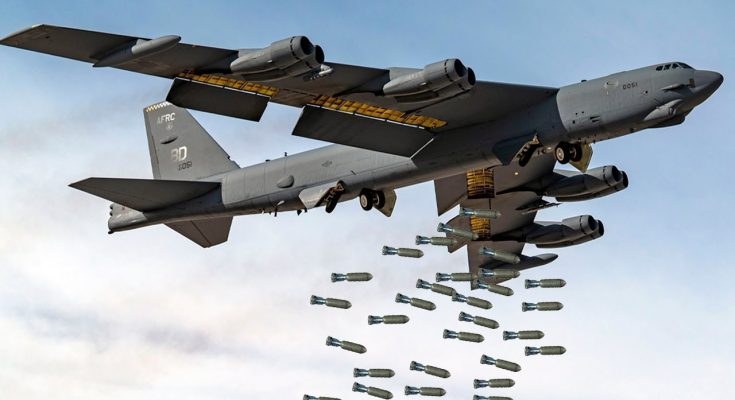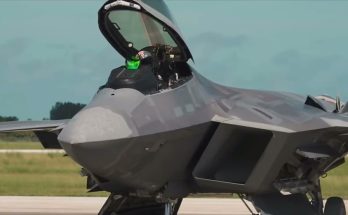In a dramatic display of U.S. military readiness, a B-52 Stratofortress bomber recently made an emergency takeoff at full speed, sending a clear message about the American military’s ability to respond swiftly and decisively in high-stress situations. The event, which occurred at a U.S. airbase, has captivated military experts and analysts worldwide, showcasing the enduring power and capability of the B-52—an aircraft that has been in service for over 60 years but remains one of the most potent weapons in the U.S. Air Force’s arsenal.
The B-52 Stratofortress: A Legacy of Power
The B-52 Stratofortress is one of the longest-serving aircraft in military history, having first entered service in 1955. Built by Boeing, the B-52 was originally designed as a long-range nuclear bomber during the Cold War, capable of carrying massive payloads of conventional or nuclear bombs across great distances. Despite its age, the B-52 has undergone multiple upgrades over the decades, including enhanced avionics, engines, and weapons systems, ensuring its continued relevance in modern warfare.
The aircraft is known for its incredible range, high payload capacity, and ability to deliver devastating firepower. With a top speed of around 650 mph and a combat radius of over 8,800 miles, the B-52 can conduct strategic bombing missions across vast areas, making it a critical asset for the U.S. military.
The Emergency Takeoff: High-Speed Response
The emergency takeoff that captured the attention of military observers was a demonstration of the B-52’s ability to quickly mobilize under high-pressure conditions. Reports indicate that the bomber’s takeoff speed was significantly higher than normal, showcasing its ability to accelerate rapidly and take flight even in an emergency scenario.
Emergency takeoffs, particularly at full speed, are a rare and high-risk maneuver that demonstrate both the capability of the aircraft and the precision of the crew operating it. In this case, the B-52’s crew was able to execute a rapid response, demonstrating the bomber’s ability to be deployed quickly in the event of a time-sensitive military crisis. The maneuver also tested the aircraft’s engines, which have been modernized to ensure greater fuel efficiency and power for rapid takeoff.
This exercise reflects the U.S. military’s commitment to maintaining a constant state of readiness, able to respond to unforeseen threats at a moment’s notice. The B-52’s ability to execute such maneuvers emphasizes its continued relevance, even in an era dominated by newer, stealthier platforms like the B-2 Spirit and B-21 Raider.
Strategic Significance of the B-52
The B-52’s role in modern warfare may seem less glamorous compared to cutting-edge stealth bombers, but its strategic importance cannot be overstated. The aircraft’s ability to carry a wide array of conventional and nuclear weapons gives it unparalleled flexibility. Furthermore, its sheer size and long-range capability make it an ideal platform for conducting global deterrence missions.
One of the most significant aspects of the B-52’s continued relevance is its role in nuclear deterrence. In a time of rising global tensions, particularly with adversaries like Russia and China, the B-52 serves as a powerful reminder of the U.S. military’s second-strike capability. Its ability to carry nuclear bombs and perform strategic strikes makes it a crucial component of the U.S. Air Force’s nuclear triad, alongside submarines and intercontinental ballistic missiles (ICBMs).
Additionally, the B-52 is often deployed for conventional combat operations, including precision strikes against enemy targets, close air support for ground forces, and long-range interdiction missions. Its wide array of bombs and missiles allows it to target everything from hardened bunkers to enemy supply lines.
The B-52 in the Modern Military Landscape
Despite its age, the B-52 has proven itself to be adaptable to modern threats. Recent upgrades have included new weapons systems, such as precision-guided munitions (PGMs), which increase its effectiveness in modern combat scenarios. The addition of advanced avionics and radar systems ensures that the B-52 can operate effectively in contested environments, even against adversaries with advanced anti-aircraft capabilities.
The B-52 is also often deployed in joint operations with other military branches, such as the U.S. Navy and allied forces, further enhancing its versatility and global reach. Its ability to operate from various bases around the world gives the U.S. military a robust and flexible presence in key regions, such as the Middle East and the Indo-Pacific.
Implications for Global Security
The emergency takeoff of the B-52 is a clear indication that the U.S. military is ready to respond swiftly to any crisis, reinforcing its position as a global military power. In a world where tensions between great powers are rising, particularly in regions like the South China Sea and Eastern Europe, the readiness of the U.S. military to mobilize at a moment’s notice is crucial for maintaining global stability.
For adversaries, the sight of a B-52 taking off at full speed is a reminder of the vast military capabilities the U.S. possesses—both in terms of firepower and rapid deployment. While newer, more advanced aircraft may garner more attention in the media, the B-52’s emergency takeoff serves as a testament to the enduring relevance of legacy platforms that have been continuously upgraded and remain integral to U.S. military strategy.
Conclusion
The high-speed emergency takeoff of the B-52 Stratofortress is a powerful demonstration of the U.S. military’s ability to respond quickly and decisively in the face of an emergency. This iconic aircraft, which has been a cornerstone of American air power for over six decades, continues to evolve and adapt to modern threats, ensuring its place in the future of military operations. The B-52’s flexibility, firepower, and strategic importance make it a vital asset for the U.S. military, reinforcing its commitment to maintaining global security and readiness in an unpredictable world.



